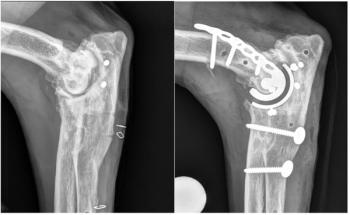
Ragdolls, rottweilers, and rats: Perioperative analgesic techniques for every species (Proceedings)
Poorly managed pain, whether before, during, or after anesthesia, can have a number of harmful consequences.
Poorly managed pain, whether before, during, or after anesthesia, can have a number of harmful consequences. Most publications on the subject of pain management in both “traditional” canine/feline patients and “non-traditional” exotic patients show appropriate analgesia and pain management to be essential to wound healing and patient recovery. Still, many patients do not receive adequate analgesia in the peri- and post-operative periods. Creating analgesic plan for any patient-cat, dog, rabbit, rat, turtle--requires the anesthetist to consider anticipated pain level and to find ways to utilize all the tools in the analgesic tool box. Fear over negative reactions can be alleviated by being aware of complications and contraindication associated with analgesic drugs and techniques used in the perioperative period.
To better understand how to manage pain, one should have a fluency in the “language” of pain:
- Pain: an unpleasant sensory and emotional experience associated with actual or potential tissue damage; the perception of nociception
- Nociception: the activity produced in the nervous system by noxious stimuli
- Analgesia: absence of pain in response to normally painful stimuli
- Hyperalgesia: an increased response to a normally painful stimulus
- Allodynia: pain due to a stimulus that does not normally produce pain (i.e. touch)
- Central Sensitization: “Wind up pain;” changes in the central nervous system that occur as a result of repeated or chronic painful stimulus
- Analgesic: an agent or drug that causes or allows for relief from pain; a “pain killer”
The pain pathway in the body can be broken down into four basic groups: transduction, transmission, modulation, and perception. Analgesics and analgesic techniques work to modify to pain felt and transmitted throughout the circuit. Different analgesic drugs work on different parts of the pathway.
- Transduction: change of cellular chemical information into electrical impulses that travel the spinal cord
- Drugs that work at this point: local anesthetics, opioids, NSAIDs
- Transmission: travel of the pain impulse; transmitting the signal to the brain
- Drugs that work at this point: local anesthetics, alpha 2 agonists
- Perception: cognizant recognition of painful stimulus
- Drugs that work at this point: opioids, alpha 2 agonists
- Modulation: Brain and spinal cord communicate and work together to change or modify the painful sensation
- Drugs that work at this point: local anesthetics, opioids, alpha 2 agonists, tricyclic antidepressants, NMDA antagonists, NSAIDS, anti-convulsants
When creating an analgesic plan, use common sense. If the procedure would cause pain to a human, assume it would cause pain to animal patients. It is the moral and professional obligation of veterinary staff to be on the front line of pain management in their patients. Primary analgesic agents available are: Opioids, NSAIDs, Alpha 2 Agonists, NMDA Agonists, and Local Anesthetics.
Opioids
Opioids fall into three groups: agonist-antagonist, partial agonist, and agonist. Opioids work directly at the central nervous system by binding to receptors and impeding the transmission of painful stimuli. There are three primary opioid receptors: mu, kappa, and delta. They are proven to be safe, effective, with rapid onset and are reversible.
Butorphanol
- Agonist-antagonist
- MINOR analgesia
- Minimal sedation
- Short acting (30-60 minutes)
- Minimally painful procedures
- Minimal vomiting/respiratory depression/CV depression
Buprenorphine
- Partial agonist
- Mild to moderate analgesia
- Minimal sedation
- 6-8 hours
- Works very well in cats, but not well in dogs
Minimal vomiting/respiratory depression/CV depression
Morphine, hydromorphone, oxymorphone
- Opioid agonist
- Moderate to high level of analgesia
- Good sedation
- 3-4 hours
- If given IM can cause vomiting and pytalism
- Morphine can cause histamine release
- May cause respiratory depression/CV depression
Methadone
- Opioid agonist
- Moderate analgesia
- Moderate sedation
- 4-6 hours
- If given IM can cause vomiting and pytalism
- May cause respiratory depression/CV depression
Fentanyl
- Opioid agonist
- Moderate to high level of analgesia
- Good sedation
- 20-30 minutes; must be given as CRI
- May cause respiratory depression/CV depression
NSAIDs
Non-steroidal anti-inflamatory (NSAID) agents work by block the enzymes COX-1 and COX-2, which are associated with inflammation. They have a long duration of action, 12-24 hours, and are not considered a controlled substance. Using an NSAID alone is never appropriate for managing extreme pain, but they can be used singly when dealing with mild to moderate pain. NSAIDS are commonly used for ongoing conditions where surgery is not a viable option, such as arthritis, dental disease, or cancer. NSAIDS are not enough to manage surgical pain, but are suitable to use following a surgical procedure when opioids are no longer necessary. NSAIDs are often used in conjunction with opioid analgesics, allowing for multimodal analgesia. Side effects include GI ulceration, nephrotoxicity, hepatotoxicity, and platelet impairment. NSAIDs are metabolized by the liver and excreted by the kidneys; they should not be used in patients with hepatic or renal dysfunction, gastric ulcers, hypovolemia, or platelet impairment.
Alpha 2 agonist
Alpha-2 adrenergic agonists provide sedation and provide minor analgesia Dexmedetomidine is the most commonly used alpha-2. This class of drug can cause respiratory depression, but it varies greatly from patient to patient. This class of drug can cause dark mucous membrane color that is unrelated to oxygenation of tissue. It can cause profound bradycardia and vasoconstriction. This class of drug is only an appropriate choice for relatively healthy patients and cannot be used on any patient with cardiac compromise. Alpha-2s cause vomiting in most cats and many dogs, though this is much less when given intravenously; they are reversed with atipamezole.
Local anesthetics
Infiltrations of local anesthetics can be used in an almost limitless number of situations. They are used for incision line blocks, ring blocks for digit or tail amputations, testicular blocks for castration, or brachial plexus nerve blocks for forelimb surgeries. There are also several dental blocks that can be mastered and utilized. Side effects associated with local anesthetic agents including depression, nausea, hypotension and arrhythmias. The biggest concern is over toxicity which can lead to seizures and cardiac dysfunction.
Eutectic mixture of local anesthetic (EMLA) creams are an amazing and under- utilized tool in the territory of pain management, particularly in exotic pets. A small amount is applied to a shaved and cleaned area, covered with a non-porous material such as plastic wrap or tegaderm and allowed to sit for 20 to 30 minutes. The area is desensitized and can facilitate procedures such as catheter placement, skin biopsies, or other minor procedures.
Epidural analgesia
Epidurals are given as either single injections using one time spinal needles or continual boluses/constant rate infusions using an epidural catheter. When using any drug in the epidural space, local anesthetic or opioid, make absolutely certain the drug is preservative free. Many of the common preservatives used: sodium bisulfate, metabisulfite, edatate disodium, formaldehyde or phenol, have been shown to have neurotoxic effects when placed directly on the spinal cord.
Local anesthetics are commonly used in epidurals, either singly or in combination with an opioid analgesic. They are effective within 5 to 30 minutes, depending on the local anesthetic chosen and can have a duration up to 6 hours. Local anesthetics work by causing sensory and motor blockade and will desensitize the hind limbs, abdomen, tail, and anal region. Lidocaine and bupivicaine are the most commonly used local anesthetics. Lidocaine has a short onset-10-15 minutes-as well as a limited duration of only 1-2 hours. Bupivicaine has a longer onset-20-30 minutes, but also has a duration of 2-6 hours. Lidocaine is typically given at 2mg/kg and bupivicaine at 1mg/kg-keeping in mind the volume limit of 0.2ml/kg that is allowed by the epidural space. Local anesthetics are often combined with opioid analgesics to provide a quick onset of sensory and motor blockade and allow for multimodal analgesia.
Adverse reactions to local anesthetics include hypoventilation, primarily occurring if the local anesthetic has migrated cranially and caused paralysis of the respiratory muscles. This may require the patient to be mechanically or hand ventilated (only until the effect of the local anesthetic has worn off). Ataxia, hypotension, Horner's syndrome, and Shiff-Sherrington-like activity are other rare but acknowledged reactions. In the event of a toxic level of local anesthetic, muscle twitches, convulsion, coma, and death may occur.
Morphine is typically given at 0.1mg/kg. It has a long time until on-set, 30-60 minutes, but also an extremely long duration of effect, anywhere from 10-24 hours. When given intramuscularly, morphine often causes bradycardia, hypotension, and hypoventilation, but when delivered epidurally the side effects are minimal. It also does not typically cause negative locomotor effects. Depending on the volume used in the epidural, it can spread far enough cranially to be effective for thoracic surgeries.
Fentanyl is a highly lipid soluble opioid that is historically used as an intravenous constant rate infusion. It has exciting applications in terms of epidural analgesia that are not always fully utilized. When given intravenous, fentanyl has an onset of just a few minutes, but only lasts about 20 minutes, which is why the CRI is essential for maintenance of analgesia. It can be given at 2-25mcg/kg/hr. When fentanyl is delivered into the epidural space the onset is about 15-20 minutes and the duration is 3-5 hours. The best application for fentanyl epidurally is a combination of epidural catheter and constant rate infusion through the catheter. It allows for excellent titration of analgesia and can be used for the most painful surgeries, including limb amputations and thoracotomies. The CRI can be maintained post-operatively and the level of analgesia adjusted as needed.
Side effects universal to opioids include respiratory depression and dysphoria, though incidence of this is less than with intramuscular or intravenous administration. Constipation and decreased gastrointestinal motility are commonly seen. Urinary retention is a commonly reported occurrence and the patient should be monitored for appropriate urination. It may be necessary to place a urinary catheter or manually express the bladder as needed.
Constant rate infusions (CRIs)
CRIs help maintain adequate anesthetic depth and allow inhalant levels to be kept low. Most analgesic agents can be run as a CRI--ketamine, lidocaine, fentanyl, hydromorphine, butorphanol, morphine, and dexmedetomidine. Many work best when in combinations such as MLK (morphine, lidocaine, ketamine), FLK (fentanyl, lidocaine, ketamine) or HLK (hydromorphone, lidocaine, ketamine). CRIs are beneficial in that they allow for a steady plane of analgesia without the side effects usually associated with bolus dosing. Less of the drug is given overall, thus making this approach more cost effective as well.
References
Skarda, Roman T. and Tranquilli, William J. 2007. Veterinary Anesthesia and Analgesia, 4th edition. Ames (IA): Blackwell Publishing.
Additional reference available upon request.
Newsletter
From exam room tips to practice management insights, get trusted veterinary news delivered straight to your inbox—subscribe to dvm360.






